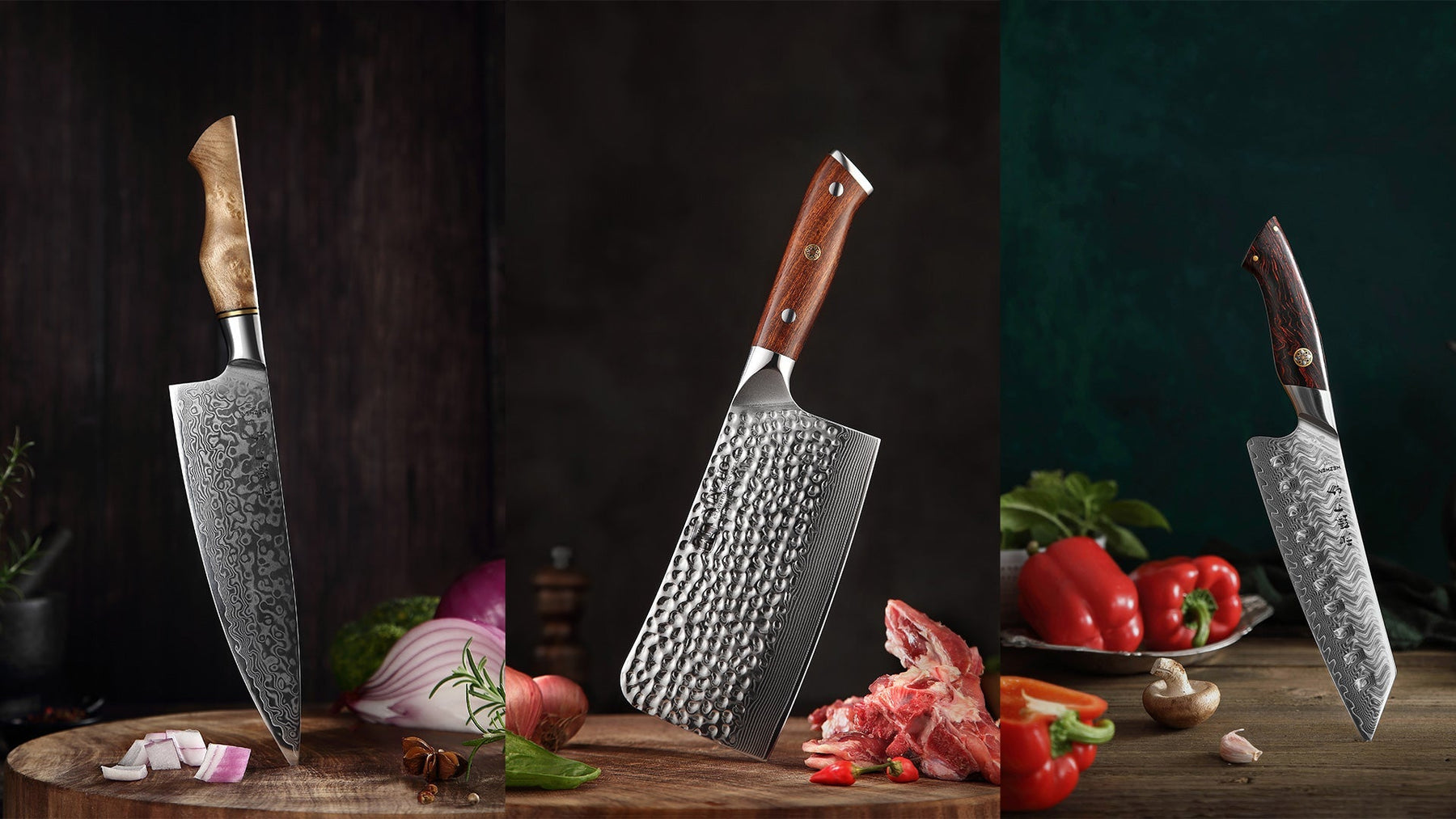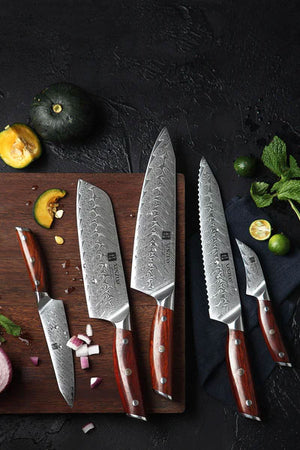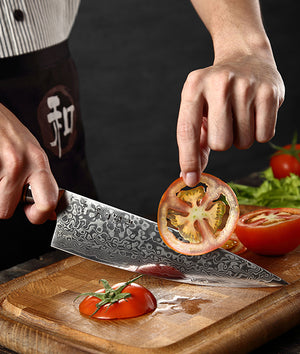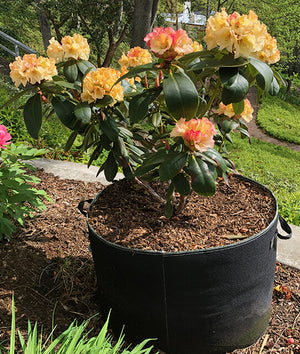
The Art of Damascus: What Makes These Kitchen Knives Unique?
Damascus kitchen knives are a perfect blend of ancient artistry and modern functionality. These exceptional blades feature unique wavy patterns on their surfaces, creating a captivating play of light and shadow that sets each knife apart.
But there's more to Damascus knives than just their stunning looks. They embody a long-standing tradition of metalworking excellence, crafted through a meticulous process of folding and forge-welding different types of steel. This technique results in blades that are:
- Exceptionally sharp with superior edge retention
- Incredibly durable due to their layered construction
- Visually stunning with unique pattern variations
- Perfectly balanced for precise cutting control
In this guide, you'll discover the rich heritage behind Damascus steel, learn about modern crafting techniques, and understand what makes these knives prized possessions in professional kitchens worldwide. You'll gain insights into selecting the perfect Damascus knife for your needs and master the art of maintaining these beautiful blades for generations to come.
Aside from traditional knives, it's also worth exploring other kitchen tools that can enhance your cooking experience. For instance, multi-functional detachable stainless food cooking shears can be an invaluable addition to your kitchen arsenal. These versatile shears make tasks like cutting through meat or opening packaging much easier.
The Historical Allure of Damascus Steel
Damascus steel has a long and fascinating history. Its origins are believed to be in ancient civilizations. Some debate exists about whether it was first developed in India, Persia, or Syria. The name "Damascus" likely comes from the capital city of Syria, where these extraordinary blades were traded along the Silk Road during medieval times.
The Birthplace of Damascus Steel
The original form of Damascus steel, known as wootz steel, was created in India around 300 BCE. This legendary material had unique watery patterns and possessed remarkable qualities:
- Exceptional hardness while still being flexible
- Self-sharpening edges due to its special microstructure
- Distinctive watery patterns that formed naturally during the forging process
The Secret Craftsmanship Behind Wootz Steel
Ancient blacksmiths crafted these incredible blades using a secret method of heating and folding specific types of iron ores with precise carbon content. This technique was closely guarded and passed down through generations of skilled artisans.
The Evolution of Damascus Steel Production
Meanwhile, in the Nordic regions, smiths independently developed a technique called pattern welding. This method involved repeatedly folding and forge-welding different kinds of steel to create similar visual effects as those seen in wootz steel. Over time, this technique evolved into what we now know as modern Damascus steel production, although it differs from the original wootz process.
The Lost Art of Wootz Damascus Steel
Unfortunately, the true art of making wootz Damascus steel was lost in the 18th century. In recent years, modern metallurgists and bladesmiths have dedicated significant time studying ancient Damascus blades in an effort to uncover their mysteries. Through advanced techniques like electron microscopy and chemical analysis, they have discovered the presence of carbon nanotubes and carbide nanowires within these blades—an explanation for their exceptional characteristics.
The Enduring Legacy of Damascus Steel
Today, the legacy of Damascus steel lives on through high-quality kitchen knives such as the XINZUO B37 Japanese Damascus Steel Chef Knife or the Xinzuo Zhen Series 67 Layer Damascus Japanese Chef Knife These knives not only showcase the superior qualities associated with this type of metal but also serve as indispensable tools for both professional chefs and home cooking enthusiasts alike.
Additionally, Japanese Damascus stainless steel steak knives like the TBG9 set feature razor-sharp blades with comfortable grip handles—perfect for savoring delicious cuts of meat.
Modern Mastery: Crafting Damascus Knives Today
Modern Damascus knife crafting blends traditional techniques with advanced metallurgy. Today's master bladesmiths work primarily with high-carbon steel and nickel alloys, creating blades that feature 49-145 layers of carefully forged metal.
Selecting Premium Steel Billets
The creation process starts with selecting premium steel billets:
- VG10 Japanese steel core
- High-carbon steel outer layers
- Nickel alloy additions for enhanced pattern definition
The Art of Pattern Welding
The magic happens in the forge at precise temperatures between 1,500-2,000°F (815-1,093°C). Master craftsmen repeatedly heat, fold, and hammer the metal, creating distinct layers through a process called pattern welding. Each fold doubles the number of layers, with most premium Damascus knives featuring:
- 49 layers - Standard premium grade
- 145 layers - Ultra-premium grade
The Benefits of Layering Technique
The layering technique serves both aesthetic and functional purposes:
- Enhanced edge retention
- Superior strength and flexibility
- Unique pattern formation
- Resistance to chipping
Advantages of Modern Technology in Damascus Knife Making
Modern Damascus knives benefit from precise temperature control and advanced forging equipment. These tools allow craftsmen to achieve consistent results while maintaining the artistic elements of traditional Damascus steel. The process combines mechanical pressing, hand hammering, and carefully controlled cooling cycles to create the signature wavy patterns that make each blade unique.
The Dance of Patterns: Aesthetics and Functionality in Damascus Knives' Design
Damascus steel's signature patterns create a mesmerizing visual display that sets these knives apart. Each pattern tells a story of the blade's creation through distinctive designs:
- Feather Pattern
- Resembles delicate bird feathers flowing across the blade
- Created through repeated folding and manipulation of steel layers
- Displays intricate, symmetrical lines that catch light beautifully
- Twisted Pattern
- Features dramatic swirls and spirals along the blade's length
- Achieved by twisting the steel billet during the forging process
- Creates dynamic movement that draws the eye along the knife's surface
- Raindrop Pattern
- Exhibits circular formations reminiscent of rain falling on water
- Requires precise hammering techniques during the folding process
- Results in a three-dimensional effect that adds depth to the blade
These patterns serve beyond aesthetics- revealing the blade's structural integrity. The visible layers indicate proper forge welding and successful material integration. A well-executed pattern signals skilled craftsmanship and suggests superior blade performance.
Modern Damascus knives showcase patterns ranging from subtle, understated designs to bold, dramatic compositions. The 67-layer Damascus steel, common in premium knives like the Xinzuo PM8O series, allows for particularly intricate pattern development. Each blade becomes a artistic expression while maintaining its fundamental purpose as a precision cutting tool.
Performance Beyond Compare: Why Chefs Prefer Damascus Knives
Professional chefs choose Damascus knives for their exceptional cutting performance and remarkable edge retention. These blades slice through ingredients with precision, requiring minimal force and creating clean, uniform cuts that preserve the integrity of your ingredients.
Unmatched Cutting Performance
The layered steel construction creates micro-serrations along the cutting edge, enhancing the blade's ability to grip and slice through food with minimal resistance. This unique characteristic makes Damascus knives particularly effective for:
- Precise vegetable cuts - achieving paper-thin slices
- Clean protein preparation - reducing meat fiber damage
- Delicate herb work - preventing bruising and discoloration
Damascus knives maintain their razor-sharp edge significantly longer than standard stainless steel knives. The alternating layers of hard and soft steel create a self-strengthening structure that resists wear and damage. A well-maintained Damascus blade can retain its edge for months of regular use.
Built to Last
The durability of Damascus knives stems from their multi-layered construction. Each layer adds structural integrity, making these knives resistant to:
- Chipping
- Bending
- Impact damage
- Corrosion
The hardened steel core, typically ranging from 60 ±1 on the Rockwell scale, provides exceptional strength while maintaining flexibility. This balance allows Damascus knives to withstand the rigors of professional kitchen use while delivering consistent performance day after day.
Proper Care for Longevity
To ensure the longevity and performance of these high-quality blades, proper care is essential. Using specialized products like Clark's Coconut Cutting Board Oil can help maintain wooden surfaces such as cutting boards that come in contact with food. Additionally, employing Clark's Wax Buffing Pads can effectively revitalize a variety of wood products.
For more delicate tasks like peeling or trimming, a Xinzuo B32 Feng Paring Knife—known for its razor-like sharp edges—could be an excellent addition to your kitchen arsenal.
Aesthetic Appeal and Collectability: The Dual Nature of Damascus Knives as Kitchen Tools and Art Pieces
Damascus knives are more than just kitchen tools; they are also valuable collectibles that showcase skilled craftsmanship and mesmerizing beauty. Each blade has its own unique design, with patterns ranging from intricate swirls to captivating waves created by carefully folding layers of steel.
The Visual Allure of Damascus Knives
The beauty of Damascus knives comes from their unique one-of-a-kind features:
- Rippling Patterns: Every Damascus blade has a different pattern, making each knife a one-of-a-kind work of art.
- Light Play: The layered steel gives the blade a three-dimensional look, with light reflecting off its surface in an enchanting way.
- Surface Texture: The different layers of steel create subtle variations in texture that can be felt when you touch the blade.
Factors Contributing to the Collectible Value of Damascus Knives
Several factors contribute to the increased value of Damascus knives among collectors:
- Limited Production: Skilled craftsmen produce these blades in small quantities.
- Artisan Signatures: Many pieces bear the unique style of famous knife makers.
- Material Quality: The use of high-quality steel alloys improves both performance and worth.
The Growing Market for Damascus Knives
The demand for Damascus knives continues to rise as enthusiasts recognize their dual appeal as practical tools and valuable investments. Many collectors take pride in displaying their Damascus knives alongside using them, appreciating both their functionality and artistic beauty.
Choosing Your Perfect Damascus Knife: A Guide for Enthusiasts
Selecting your ideal Damascus knife requires careful consideration of several key factors that directly impact your cooking experience. Let's explore the essential elements that will guide your decision:
- Size Considerations
- 8-inch chef's knife: Perfect for all-around kitchen tasks
- 6-inch utility knife: Ideal for precise cutting and detailed work
- 10-inch blade: Suited for larger ingredients and professional kitchen environments
- Weight Distribution
- Heavy blade (200g+): Allows gravity to assist in cutting
- Medium weight (150-200g): Offers balanced control and maneuverability
- Light blade (<150g): Provides agility for quick, precise cuts
- Balance Points
- Handle-heavy: Reduces wrist fatigue during extended use
- Blade-heavy: Enhances cutting power and precision
- Neutral balance: Offers versatility across different cutting techniques
- Handle Ergonomics
- Traditional wooden handles: Natural feel with excellent grip
- Modern G10 handles: Weather-resistant with consistent performance
- Custom-fitted handles: Tailored to your hand size and grip style
Your knife should feel like a natural extension of your hand. Test different sizes and weights when possible, paying attention to how the knife responds during various cutting motions. The right Damascus knife combines these elements to match your cooking style and preferences. For instance, if you're looking for a reliable chef's knife, you might want to consider the Xinzuo B13R 8.5" 67 Layer Japanese Damascus Chef knife This knife combines function and artistry with its Japanese-themed blade styles.
Similarly, if you're in need of a versatile carving knife, the Xinzuo B9 Yun Series Full Tang 8" 67 Layers Damascus Carving Knife could be an excellent choice. It's designed for various tasks including slicing through poultry and roasts.
For those who bake often, a bread knife with serrated blades is essential. This type of knife is specialized yet fairly essential - perfect for slicing through thick crusts and delicate pastries without crushing them.
Lastly, if you're looking for a meat slicing option, the Xinzuo B35 12" Granton German Steel Carving Knife could be what you need. This carving knife is sturdy and ideal for heavy-duty tasks like big prime rib roasts. If you are looking for a big carving knife to carve that special turkey, the HEZHEN B38H 67 Layer Japanese Damascus Carving Knife is a great go-to carving knife.
Why Choose a Damascus Knife?
Damascus knives are renowned for their exceptional quality and performance, making them a preferred choice for enthusiasts, collectors, and professionals alike. Here's why they stand out:
Unparalleled Sharpness
The high-carbon content in Damascus steel contributes to a razor-sharp edge that holds its sharpness longer than many other knives. The intricate layering of different steel types during the forging process creates a superior edge retention, making Damascus knives perfect for tasks that require precision cutting. Whether you're slicing vegetables, deboning meat, or performing fine cutting tasks, you’ll appreciate the effortless glide through materials that Damascus knives offer.
Durability & Strength
Damascus steel's layered construction doesn't just provide aesthetic appeal—it also contributes to the knife's durability and strength. The fusion of hard and soft metals creates a blade that is both resilient and flexible. This balance helps the knife maintain its form even under intense use, preventing it from chipping or breaking under pressure. The flexibility of the blade also reduces the risk of snapping, making Damascus knives ideal for heavy-duty tasks that require toughness without sacrificing performance.
Unique Aesthetic Appeal
Each Damascus knife features a one-of-a-kind pattern that is as much a work of art as it is a tool. The distinct swirling patterns that emerge from the layering and folding process are created by the unique combination of different metals and the forging techniques used. No two Damascus knives are identical, making each blade an exclusive piece. The aesthetic appeal of these knives makes them a prized addition to any collection or kitchen, enhancing both function and style.
Collector's Value
The artistry, craftsmanship, and historical significance of Damascus knives elevate their value. Traditionally, Damascus steel was prized by ancient civilizations for its ability to produce sharp, durable blades that were used in battle. Today, this rich history combined with modern forging techniques has made these knives highly coveted by collectors. Their rarity, beauty, and the time-intensive process required to produce them make Damascus knives a valuable addition to any collection, often appreciating in value over time.
How to Maintain Your Damascus Knife
Damascus knives require some attention to ensure they continue to perform at their best and maintain their beautiful appearance. Regular maintenance will preserve the knife’s longevity and functionality.
Regular Cleaning
After each use, it’s important to clean your Damascus knife properly. Avoid using the dishwasher as this can cause rusting or damage to the blade and ruin a wood handle. Instead, wash your knife by hand with warm water and mild soap. After washing, dry the blade and handle immediately with a soft towel to prevent water spots or corrosion.
Oil the Blade
Damascus knives require protection against moisture to prevent rust. A thin layer of mineral oil should be applied to the blade periodically to create a protective barrier. This oil coating helps maintain the blade’s luster while shielding it from environmental elements like humidity. Use a soft cloth to rub the oil gently along the blade, ensuring even coverage without excess buildup. The oil will also help maintain the intricate patterns on the blade, ensuring that they remain sharp and beautiful.
Proper Storage
Storing your Damascus knife properly is crucial for maintaining both its functionality and appearance. Always store your knife in a dry place to avoid exposure to moisture, which can cause rust. Consider using a blade sheath or a high-quality knife block to protect the blade from physical damage. Storing the knife in a protective case when not in use will also prevent it from rubbing against other kitchen tools or surfaces, which can dull or scratch the blade. If you have several knives options like Magnet knife block, knife block, and in-drawer knife blocks are great ways to protect your investment.
Sharpening
Sharpening is key to maintaining a Damascus knife’s cutting performance. To keep the edge sharp, use a whetstone or sharpening stone designed for high-carbon steel to keep the edge sharp. The whetstone provides a finer, more controlled sharpening process, allowing you to hone the blade without removing excessive material. An Honing Rod is your knife’s best friend. It realigns the blade without taking metal, helping maintain the sharpness for a longer period of time. You can’t overdo honing. Professional chefs will use their honing rod before cutting anything.
Modern Applications of Damascus Knives
While originally used for weaponry, Damascus knives have evolved and found applications in various fields. Their outstanding properties make them highly versatile tools suited for a range of modern uses.
Kitchen Knives
Chefs and home cooks alike appreciate the precision and sharpness that Damascus knives offer. Their ability to hold a sharp edge makes them ideal for slicing, dicing, and chopping tasks. With their superior edge retention, these knives can maintain cutting efficiency for longer periods, even with frequent use. Additionally, the aesthetic appeal of Damascus blades adds elegance to any kitchen, making them not only functional but also a stylish addition to your culinary tools.
Custom & Collector's Pieces
Many artisans today craft Damascus knives as custom-made, one-of-a-kind pieces, blending functionality with artistry. These knives can be used as display items, functional art, or even as heirloom pieces passed down through generations. The intricate patterns and craftsmanship that go into creating each Damascus knife add to its charm, making them desirable among collectors. Whether for display or for use, these knives reflect both the rich history of Damascus steel and modern craftsmanship.
Conclusion
Damascus knives are a perfect blend of beauty and practicality in the world of cooking. These knives are more than just tools; they each have a unique story to tell through their intricate designs, expert craftsmanship, and outstanding performance.
Investing in a Damascus knife offers two benefits: a top-notch cutting tool that elevates your cooking experience and a beautiful piece of art that appreciates in value over time. The captivating patterns on each knife, created by skillfully layering high-carbon steels, make it truly one-of-a-kind.
Your Damascus knife becomes a beloved partner in your culinary adventures, embodying both ancient traditions and contemporary creativity. With its exceptional ability to hold an edge, well-balanced weight, and comfortable design, it delivers unmatched performance. Plus, its eye-catching look turns your kitchen into a showcase of functional art.
Select your Damascus blade carefully, maintain it with love, and it will serve you faithfully for many years while exuding timeless beauty.
FAQs
What are Damascus kitchen knives?
Damascus kitchen knives are renowned for their unique craftsmanship, which involves the ancient technique of pattern welding. These knives are characterized by distinctive patterns on their blades, created through layering different types of steel, often high-carbon and nickel-alloy steel.
What is the historical significance of Damascus steel?
The historical allure of Damascus steel dates back to ancient times, with origins in various regions. It is known for its exceptional strength and ability to hold a sharp edge. The technique of pattern welding played a crucial role in the history of knife-making, contributing to the durability and beauty of these blades.
Why do chefs prefer using Damascus knives?
Chefs prefer Damascus knives due to their superior cutting performance, sharpness, and durability. The layered construction enhances both the strength and longevity of the knives, making them reliable tools in the kitchen that can withstand rigorous use.
What types of patterns can be found on Damascus knives?
Damascus knives feature various patterns such as feather, twisted, and raindrop designs. These patterns not only enhance the aesthetic appeal of the blades but also carry significance related to the forging process and the skill involved in creating them.
How should I care for my Damascus knife?
To maintain your Damascus knife's performance and beauty, it is essential to follow proper maintenance techniques. This includes regular sharpening using appropriate methods and ensuring that you clean and dry the blade after each use to prevent corrosion.
What should I consider when choosing a Damascus knife?
When selecting a Damascus knife, consider factors such as size, weight, balance, and personal preferences. Understanding these criteria will help you find a knife that feels comfortable and performs well for your specific culinary needs.



